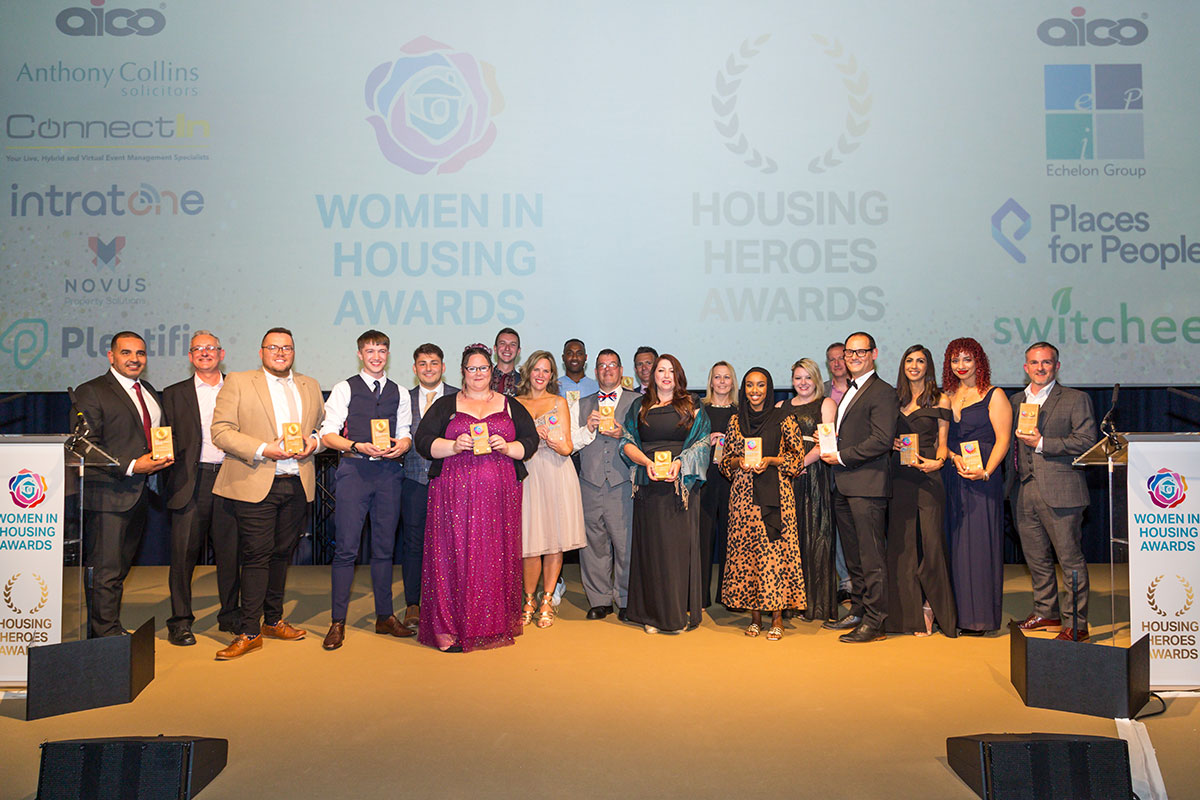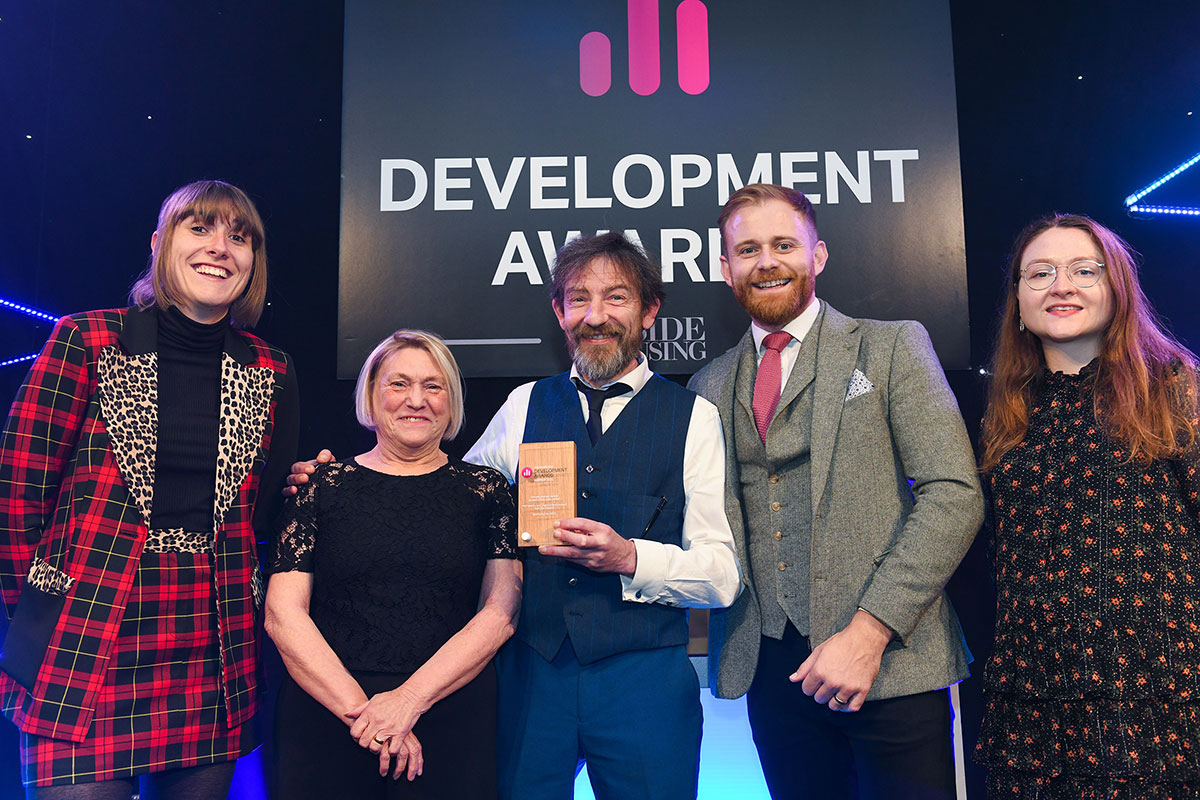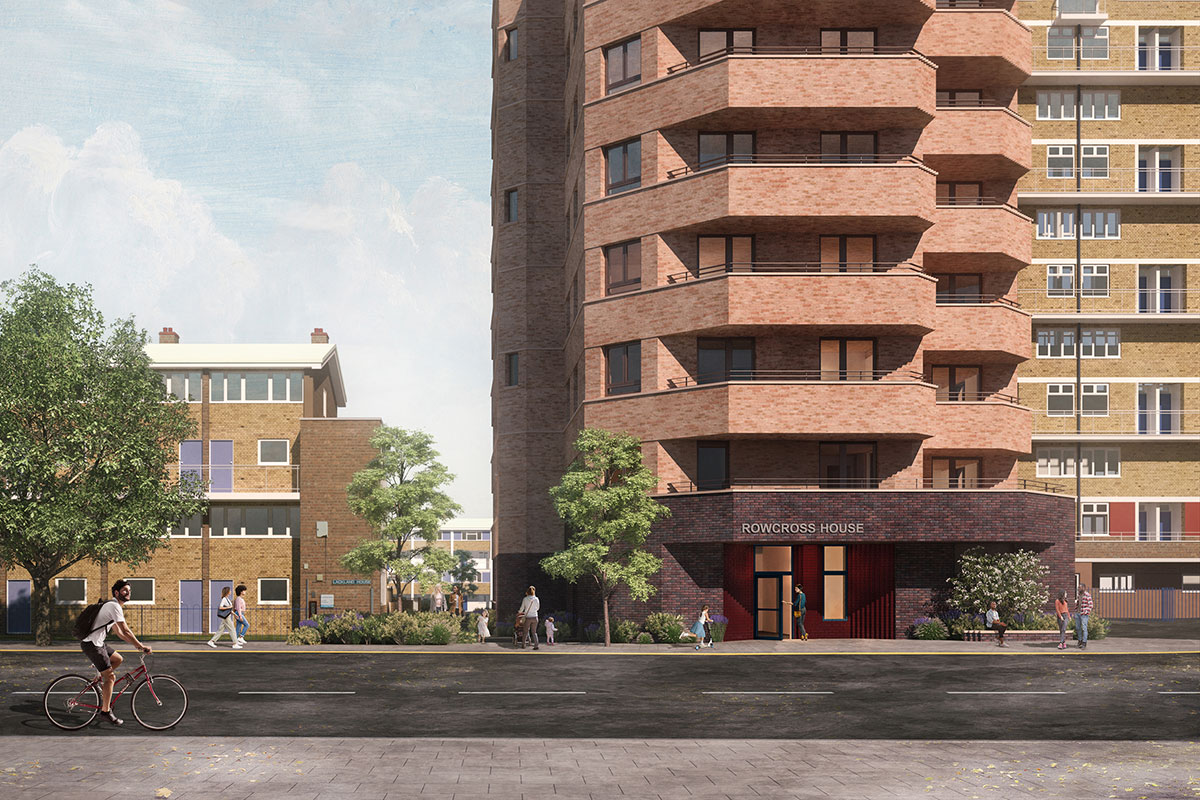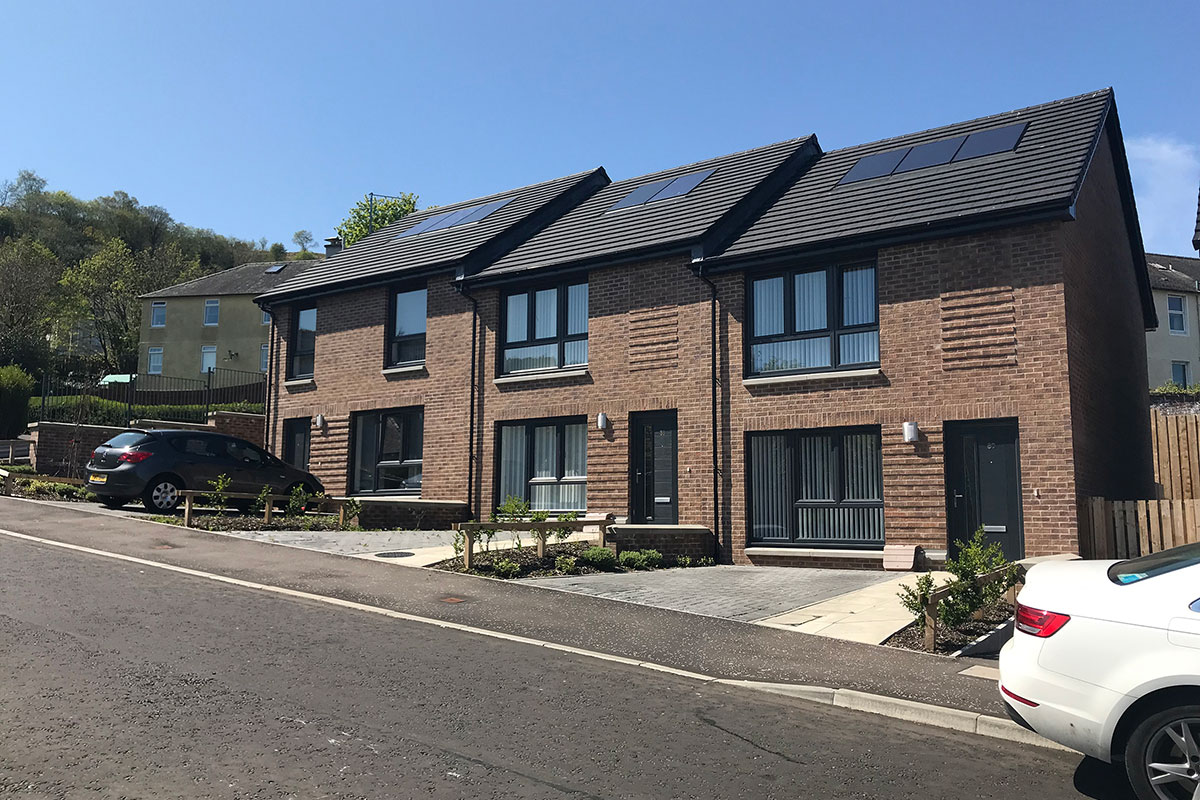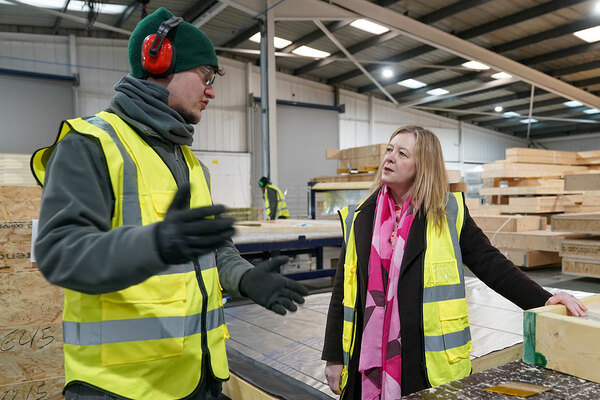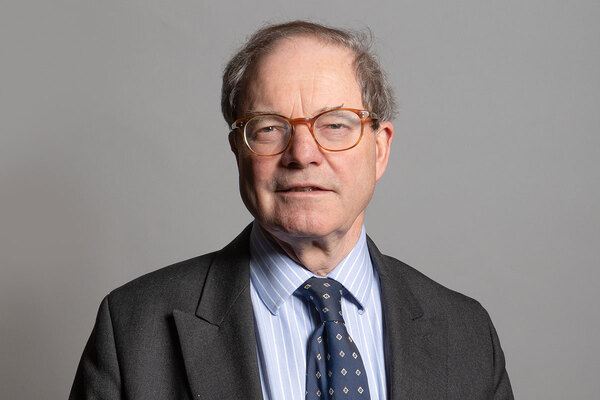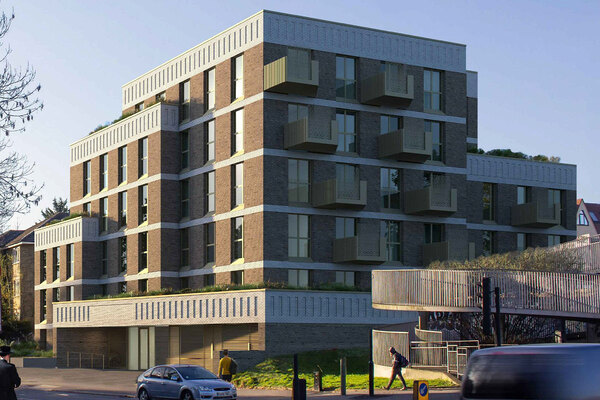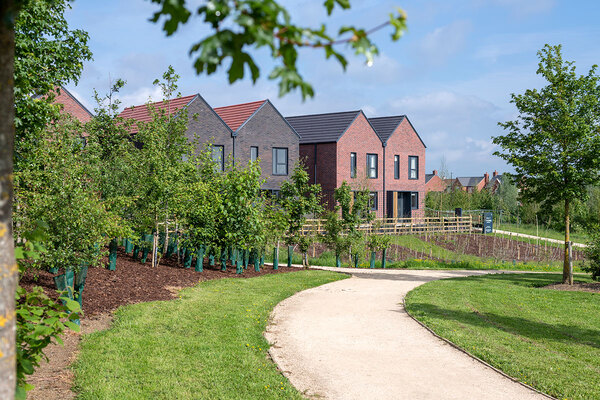You are viewing 1 of your 1 free articles
Inside Housing Development Awards 2022
Inside Housing reveals the winners of this year’s Inside Housing Development Awards. Photography by Caroline Field
On Friday, 30 September, the Inside Housing Development Awards took place at the Royal Lancaster London.
The awards celebrated the very best residential developments across the UK, recognising the teams, schemes and solutions that have made a positive impact on the communities they serve.
During the event, £2,500 was raised for foodbank charity The Trussell Trust.
The awards were judged by a panel of industry experts. Here we have highlighted the successful teams, explaining why they won.
Congratulations to all our finalists and a big thank you to everyone who submitted an entry.
Welcome to this special section celebrating the sector’s success at the Inside Housing Development Awards.
Over the following pages, we’ll be taking a look at some of the stand-out projects over the past 12 months that caught the judges’ eyes.
Despite turbulent times for all parts of the economy, with development one of the most affected, the sector has shown that it can weather stormy times to create truly brilliant homes.
The housing crisis is only going to get more acute, and there is a need for safe, warm and sustainable homes, now more than ever. If the next few pages are anything to go by, rest assured that our sector is building them.
The awards give us the chance to celebrate those who sometimes don’t have their moment in the spotlight, and show what can be done by our sector.
A huge thank you to the judges and our sponsors, who made the event possible. Now, take a look at some remarkable projects from the past year.
Jack Simpson, assistant editor (news and investigations), Inside Housing
Best healthy homes development
Olive Morris Court, Haringey Council
- A development of 32 homes that offer tailored support to people with a history of homelessness
- Built with fabric and technology designed to reduce energy costs and CO2 emissions
- Safe, secure, high-quality homes that will help residents avoid slipping into fuel poverty
Olive Morris Court is a ground-breaking development of 32 modular ‘SoloHaus’ homes.
The purpose-built accommodation provides tailored support to help residents with a history of homelessness return to independent living. The scheme provides residents with high-quality homes that help them avoid fuel poverty.
The fabric-led design includes insulation wrapped around the living area. Heat loss is further minimised by a mechanical ventilation and heat recovery system that pumps fresh air into homes while recycling heat from the extracted air.
This eliminates the need to open windows in winter and thereby reduces the demand for heating. Residents’ bills were just £5 per week when Olive Morris Court opened.
Each self-contained unit is equipped with a kitchenette, bathroom and washing machine, and is also fully furnished.
Residents here enjoy safe and secure homes that help them avoid slipping into fuel poverty.
The judges said:
“This is an eye-catching scheme; its sustainable construction approach provides a strong commitment to net zero carbon. The design is sensitive and considered”
This category was judged by:
Amir Hussain, chief executive, Yeme Architects
Jackie Rigby, head of affordable housing strategy, Homes England
Ellen Vernon, programme director of One Public Estate, Local Government Association
Sponsored by:

Climate change retrofit project of the year – rural/suburban
European Regional Development Fund retrofit programme, Northern Ireland Housing Executive
- This project aims to improve the energy efficiency of 1,900 homes across Northern Ireland
- External wall insulation and double glazing will improve living standards in 25 communities
- Three tonnes of CO2 will be saved per year and energy consumption will be reduced by 16 million kWh
The Northern Ireland Housing Executive has embarked on a multimillion-pound investment programme to improve the energy performance of nearly 1,900 homes.
The focus is on addressing the thermal efficiency of older, non-traditionally built homes through the provision of external wall insulation, new double glazing and energy efficiency measures such as improved air tightness and mechanical ventilation.
When completed, the works will raise the living standards of tenants in more than 25 communities, in 15 towns and cities.
More than 250 homes have been retrofitted to date, with more properties being completed every month.
By the end of the programme, a reduction in energy use of more than 16 million kWh per year is anticipated, as well as a reduction in carbon emissions of more than three tonnes per year.
The works have improved the health and well-being of tenants; creating warmer, healthier homes that are easier to run. The programme is leading the way in retrofitting social housing in Northern Ireland.
The judges said:
“The project has a strategic vision for the stock, delivering great outcomes for residents and a significant reduction in the amount of carbon produced”
This category was judged by:
Troy Francis, director of operations, Optivo
Eloise Shepherd, strategic lead for housing and planning, London Councils
Highly commended
Sutton Orchard, Bower Eco Homes
Sponsored by:

Climate change retrofit project of the year – urban
Hull energy and regeneration project, Hull City Council
- This project saved 126 Victorian terraced homes that were earmarked for demolition
- The council has improved the properties’ thermal performance while retaining their character
- The works have brought a sense of pride back to one of Hull’s most deprived areas
This project has installed energy efficiency measures in 126 homes that fall within the 10% most deprived areas of Hull. It has not only improved the (previously poor) thermal efficiency of these homes, but has also contributed to a reduction in fuel poverty by cutting residents’ energy consumption.
The programme involved installing external wall insulation on 126 Victorian terraced properties that had been earmarked for demolition. The original funding was withdrawn and therefore the council began to explore other ways to regenerate the neighbourhood.
This project enabled the properties to be modernised, while protecting their original architectural features. Works included brick slips, bespoke moulded windows and door headers and cills – maintaining the character of the properties and existing street features.
Feedback from residents indicate how pleased they are with the works, in particular with the insulation keeping their homes much warmer for longer. A sense of pride has been restored to the community, evidenced by residents planting gardens and hanging baskets. The project has given the whole community a new lease of life.
The judges said:
“This is a great collaborative and strategic project, which ties together sustainability, health, well-being and neighbourhood renewal”
This category was judged by:
Troy Francis, director of operations, Optivo
Eloise Shepherd, strategic lead for housing and planning, London Councils
Highly commended
Holt Park, Equans and Leeds City Council
Sponsored by:

Best older people’s development – rural/suburban
Hammerson House, Wohl Campus, Pollard Thomas Edwards and P+HS Architects
- Scheme provides a safe and welcoming home for 116 older, local, Jewish residents
- Designed with a modern country house hotel aesthetic, including a sweeping driveway
- Scheme includes many on-site facilities, making it a truly self-contained neighbourhood
Hammerson House, Wohl Campus, provides a safe, homely environment for 116 older residents from the Jewish community in Hampstead, north-west London.
As well as rooms for each resident, arranged into distinct households for varying levels of care needs, the four-storey building also offers dining rooms and communal lounges, therapy suites and spaces for festival celebrations.
The scheme has been imagined as a modern take on a country house hotel, accessed via a sweeping driveway leading to a stone entrance portal. Bedrooms sit within pitched-roof ‘houses’ defined by large windows and speckled brickwork inspired by the local arts and crafts vernacular.
The scheme recreates the buzz of London’s street life. A local store, hair salon, therapy gym, cafe, landscaped gardens and a conservatory that opens onto a courtyard combine to form a self-contained neighbourhood.
The campus also takes advantage of the site’s woodland setting, embracing the proven therapeutic benefits of natural light.
The judges said:
“A fantastic scheme, blending the local architectural style with a well considered layout and exceptional thought around residents’ social interaction, engagement and well-being”
This category was judged by:
Darren Hartley, chief executive, Taroe Trust
Amir Hussain, chief executive, Yeme Architects
Best older people’s development – urban
Solihull Village, The ExtraCare Charitable Trust
- A sustainable community for older people, built on a site that was empty for 20 years
- The scheme has a true village feel, with an outstanding range of facilities on offer
- It is well integrated with the wider community, especially local young people
Solihull Village is a 3.9-acre development on a site formerly occupied by office buildings that had been empty for more than 20 years.
Solihull Metropolitan Borough Council had been trying to regenerate the site for some time. It aligned perfectly with the council’s mission to create sustainable communities that provide the homes and lifestyles older people enjoy, as well as care, if needed.
Solihull Village is a beautifully crafted development with a large number of facilities. These include a gym, bistro, bar, village hall, arts and crafts room, hobby room, timber workshop, hairdresser, beauty salon, games room, enriched activity room for dementia care, library and rooftop gardens that have a greenhouse and allotments.
Well-being is a key focus at the village. As such, intergenerational classes take place twice a week. Groups of up to 10 children aged between nine months and four years old visit regularly to take part in library sessions and to play children’s tennis with the residents.
The judges said:
“Genuinely a pilot for what older people’s accommodation can offer in terms of ways to extend a person’s independence within a supported environment”
This category was judged by:
Fiona Creighton, executive director of homes, Mosscare St Vincent’s
Darren Hartley, chief executive, Taroe Trust
Amir Hussain, chief executive, Yeme Architects
Best development team – rural/suburban
Essex Housing, Essex County Council
- Essex Housing was created by the council to address the county’s housing shortage
- It has established a development programme that has 1,010 homes under construction
- The specialist housing units alone will save the council £1.8m annually
In the face of a housing shortage and a lack of funding, councils nationwide are trying to provide quality homes for residents and specialist housing for those with additional needs. Essex Housing was created to deal with that dilemma.
It has established a significant development programme that works collaboratively with public sector partners. The team delivers much-needed general needs and specialist housing for residents.
Developments already under way will provide 1,010 new homes, 48% of which are specialist and affordable housing to help older people and disabled people live independently.
The specialist units alone are forecast to generate annual revenue savings for the council of around £1.8m, which can then be reinvested in other vital services.
By taking a partnership approach, the Essex Housing team is innovating to deliver great quality homes and shaping fantastic places for people to live, while providing a return to reinvest in social value and improved outcomes for the residents of the county.
The judges said:
“An innovative public sector model; the team is identifying strategic housing need in the area. A balanced blend of financial and social outcomes demonstrates best value”
This category was judged by:
Mary Parsons, board member, Mobie, and director of regeneration and partnerships, Lovell Partnerships
Mark Perry, chief executive, Vivid
Jeremy Sweetland, project director, Bristol Housing Festival
Sponsored by:

Best development team – urban
Housing development and regeneration team, Enfield Council
- Enfield’s ambitious council housebuilding programme is punching above its weight
- It holds London’s third-highest delivery record in 2021-22 for GLA-funded housing
- Impressive resident and community engagement has also been a significant achievement
This team has been responsible for realising Enfield Council’s ambitious vision for building council housing. It has started to build hundreds of new family homes and specialist housing for older people over the past two years, and has achieved the third-highest delivery record among councils for homes funded by the Greater London Authority (GLA) over the past year.
Despite navigating complex inner-city contexts and the volatile post-pandemic housing market, the team completed or brought onto site 336 new homes in 2021 and began construction of 499 more in the first quarter of 2022. This looks set to continue: Enfield has received the second-highest funding allocation from the GLA in its Affordable Homes Programme 2021-26.
High levels of community engagement and resident support represent another significant achievement for this team.
This is exemplified by a highly successful estate regeneration ballot process in December 2021, where 78.5% of residents on Enfield’s Joyce Avenue and Snell’s Park Estate voted for redevelopment on a turnout of 85.5%.
The judges said:
“The council is showing visionary, values-based leadership to invest in delivering sustainable development, while building a strong narrative to bring local communities with them”
This category was judged by:
Mary Parsons, board member, Mobie, and director of regeneration and partnerships, Lovell Partnerships
Mark Perry, chief executive, Vivid
Jeremy Sweetland, project director, Bristol Housing Festival
Sponsored by:

Best shared ownership development
Merrielands, Latimer (part of Clarion Housing Group)
- One of the most affordable new developments in London, with prices starting at £50,000
- The development comprises 325 new homes, including 161 flats of all sizes for shared ownership
- Solar energy and green roofs bring down residents’ bills while encouraging biodiversity
With prices starting from just £50,000 for a 25% share of a studio apartment, Merrielands represents one of the most affordable new developments in London, enabling people who would otherwise not have been able to afford to buy a home to get on the property ladder without sacrificing style, comfort or location.
The development includes 325 homes, of which 161 are available for shared ownership, consisting of a mix of studio, one, two and three-bedroom apartments to suit a variety of buyers, from single purchasers to families.
Open-plan kitchen and living areas are filled with natural light, each opening out onto a private balcony or terrace.
The homes are set across five contemporary blocks, ranging in height from eight to 10 storeys, with landscaped open spaces and children’s play areas in between.
The homes were also designed with sustainability in mind. Solar panels contribute energy for the communal areas, reducing electricity costs for residents, while green roofs provide additional insulation, as well as promoting biodiversity.
The judges said:
“These dwellings have been designed to make optimum use of the site, while creating well-proportioned living spaces. The execution against the original design is to be commended”
This category was judged by:
Jenny Buterchi, partner, PRP
Ellen Vernon, programme director of One Public Estate, Local Government Association
Highly commended
Jonathan Street and Orsett Street, Fraser Brown Mackenna Architects
Sponsored by:

Best regeneration project – up to 100 homes
Agar Grove, Phase 1b, Mæ Architects
- A pioneering Passivhaus development that delivers great homes and tackles fuel poverty
- Extensive community consultations have informed this scheme at every stage
- Residents’ energy bills will be cut by up to 90%, reducing their risk of fuel poverty
This pioneering Passivhaus regeneration scheme seeks to deliver Camden Council’s vision for improving its housing stock by providing better-quality homes for residents and addressing fuel poverty.
To achieve this, the community and local residents were engaged throughout the design of the scheme, using a series of drop-in sessions, workshops, exhibitions and a regularly updated consultation website. These sessions were open to all estate residents and provided an opportunity to talk to and ask questions of the whole project team.
Drawing on these consultations, the scheme replaces low-rise, 1960s residential blocks with a network of safe, well-connected streets, squares and residential courtyards. This latest phase includes three blocks – villas, a terrace and a mansion block – that enclose a communal courtyard. It features front doors at ground level to build on the existing sense of community and belonging.
The scheme also sought to address fuel poverty. These Passivhaus homes cut residents’ energy bills by up to 90%, reducing the risk of fuel poverty and significantly improving the community’s quality of living.
The judges said:
“Agar Grove stitches together the complex matrix of delivering a great place to live that works for the individual and the community through connectivity and thoughtful public realm”
This category was judged by:
Kathryn Pennington, regional development director, Vistry Partnerships
Brendan Sarsfield, chair, Sustainability for Housing board
Nick Walkley, principal and president of UK strategic advisory, Avison Young
Best regeneration project – over 100 homes
Park Hill, Places for People and Urban Splash
- This project has regenerated an iconic Sheffield landmark: the Park Hill Estate
- It now boasts 450 high-quality and affordable homes, as well as a new cultural quarter
- Once a single-tenure estate, it can now flourish as a balanced, mixed-income community
Sheffield’s Park Hill Estate is a unique development. It is an icon of the city’s skyline and the largest Grade II-listed building in Europe, while being of special architectural and historic interest.
The development partners’ innovative, design-led approach to reshaping this famous building has created a desirable place to live, delivering 450 high-quality, affordable homes and creating an exciting new cultural quarter.
On the outside, Park Hill has been carefully enhanced. Colour panels were introduced to reinvigorate its exterior; on the inside, the homes have been reconfigured to meet modern needs, incorporating features such as light, airy, open-plan living spaces.
This is no longer a mono-tenure estate, but now offers homes for all, enabling the estate to become a more balanced community.
While residents have been attracted by the contemporary living spaces, the regeneration is also boosting the local economy. New commercial spaces provide employment and local services for residents and the surrounding community.
The judges said:
“Park Hill has had a transformative visual impact on Sheffield, balancing listed-building restrictions with the needs of the community and the importance of legacy public realm”
This category was judged by:
Fiona Creighton, executive director of homes, Mosscare St Vincent’s
Kathryn Pennington, regional development director, Vistry Partnerships
Brendan Sarsfield, chair, Sustainability for Housing board
Nick Walkley, principal and president of UK strategic advisory, Avison Young
Best development – rural/suburban
Bury Street West, Enfield Council
- A haven of biodiversity built on a heavily contaminated inner-city site
- 50 mixed-tenure family homes were developed in a new urban meadow that is open to the public
- Half will be let at London Affordable Rent, helping address Enfield’s need for family housing
Bury Street West is an outstanding demonstration of how an ambitious local authority can both deliver beautiful family homes and use them as a catalyst to generate a haven for biodiversity on a heavily contaminated inner-city site. The development potential of the disused council depot site in north London had long been identified, but work stalled repeatedly due to its complexity.
This scheme uses the architectural language of farm buildings to nestle family homes in a new urban meadow that is open to the public.
Fifty homes have been built across the site, 65% of which are family four-bedroom and three-bedroom properties, and 50% of which are let at London Affordable Rent, addressing a pressing need in the borough for family-sized affordable housing.
Bury Street West is a unique and exemplary housing development that sets new standards in construction quality and placemaking ambition. The scheme took a challenging urban eyesore and turned it into a rural paradise that Enfield’s residents, flora and fauna can all enjoy for a long time to come.
The judges said:
“[Enfield]’s commitment to design principles, environmental improvements and sustainability was impressive, but the commitment to creating a real community stood out”
This category was judged by:
Fiona Creighton, executive director of homes, Mosscare St Vincent’s
Joanna Davoile,executive director of assets, Wales and West Housing
Stuart Wigley, partner, Baily Garner
Sponsored by:
![]()
Best development – urban in London
The Makers, Avanti Architects
- A leading example of inner-city redevelopment in Shoreditch, east London
- 175 homes have been built to suit people at all stages of their lives
- This scheme is helping to make the neighbourhood safer, friendlier and more economically active
The Makers is a £113m, mixed-use residential and education project in Shoreditch, east London. The project delivers 175 homes and a commercial/gallery space that cross-funds a new school on the site. It includes a range of house types, designed to suit people at different stages of their lives. Green spaces throughout create an attractive and sustainable scheme.
The local community suffers from social deprivation and fragmentation. The neighbourhood also has a very limited amount of high-quality public realm and outdoor space, which contributes to anti-social behaviour. This development has become a catalyst for positive action to help tackle these issues.
The improved permeability of the area has increased footfall and passive supervision in spaces lacking security.
Improved connections between local shops have generated economic benefits for business owners, while the new public square and its connection to play areas have delivered improvements to recreational provision for young people in the area.
The judges said:
“The redevelopment and repurposing of our older town and urban centres are two of the major challenges we face, and this scheme is a leading example of how to overcome them”
This category was judged by:
Sarah Allan, head of architecture, Department for Levelling Up, Housing and Communities
Ellie Burroughs, urban designer, Custom Build Homes
David Cowans, senior strategic advisor, Regis Group
Sponsored by:
![]()
Best development – urban outside London
The Depot, Rowlinson and Buttress
- A 300-home scheme on a contaminated site that had been empty for years
- A sustainability-focused, mixed-tenure development where people of all ages can live and grow
- Partnership with other local housing-sector organisations was key to successful delivery
The Depot is a new intergenerational development. A mix of types and tenures deliver homes that fit the community’s needs, with sustainability built in. The five-acre site was contaminated by its former use as a bus depot. Despite an excellent location on a main route into Manchester city centre, the plot had stood vacant for years.
The scheme, by construction firm Rowlinson and architect Buttress, is one where generations can mix freely. People can upsize, downsize or adapt their existing space to meet their changing needs, while remaining within their community.
More than 300 new build homes form part of the development, which features a range of rented apartments, three and four-bedroom family homes, and later-living options encompassing extra-care housing and over-55s apartments.
Energy efficiency measures such as communal heating systems and solar energy combine to reduce the site’s carbon footprint and keep bills down.
The Depot is already becoming an established part of the local landscape, and has brought a neglected brownfield site back into full use.
The judges said:
“A good mix of uses and tenures delivered by a range of partners, plus a good treatment of open space for a city centre development. Impressive focus on community engagement”
This category was judged by:
Sarah Allan, head of architecture, Department for Levelling Up, Housing and Communities
Ellie Burroughs, urban designer, Custom Build Homes
David Cowans, senior strategic advisor, Regis Group
Sponsored by:
![]()
Best partnership – up to 100 homes
47 Greenleaf Road, Aston Group and London Borough of Waltham Forest
- This partnership converted a Victorian terraced home into an eco show home
- The property’s EPC band has gone from E to A, while CO2 emissions have fallen by 81%
- It has been toured by 1,800 visitors from housing associations and other stakeholders
This collaboration between Waltham Forest Council and building services provider Aston Group converted a challenging Victorian terrace into an eco show home, which the partnership has used to engage the community and empower change through education.
By introducing a range of sustainability measures – including an air source heat pump, insulation and solar panels – the property’s Energy Performance Certificate (EPC) rating has been lifted from Band E to A, and its CO2 emissions have been cut by 81%. The property now hosts tours for stakeholders, residents and housing associations; 1,800 people have already paid a visit. The partnership hopes that displaying these upgrades and improvements in a real-life setting will encourage behavioural change in other organisations and partnerships.
This project has been a huge success. It has served to educate people, helping them understand, in practical terms, how to retrofit a Victorian home. Given that 70% of the borough’s 107,216 homes were built before 1944, retrofitting is now seen as a priority in Waltham Forest’s decarbonisation plans.
The judges said:
“This important project will further our knowledge of zero-carbon retrofit. It could be a blueprint for other properties, and can help present a substantive case for retrofit”
This category was judged by:
Imran Mubeen, director of treasury, Bromford
Rajesh Shah, executive commercial director, Quintain
Claire Tristham, director of development West, Pobl Group
Sponsored by:

Best partnership – over 100 homes
Aberfeldy New Village LLP, EcoWorld London and Poplar Harca
- An exemplary demonstration of the potential of public/private partnerships
- Both parties are maximising their respective skills in regenerating an east London estate
- This 20-year project has already delivered 900 homes of all tenures, as well as many new amenities
This partnership is an exemplar of what can be achieved when the public and private sectors bring their skills together in the drive to solve the UK’s housing crisis.
In 2012, developer EcoWorld London and housing association Poplar Harca formed Aberfeldy New Village LLP, a joint venture that aims to transform the Aberfeldy Estate in east London over a period of 20 years.
Poplar Harca’s in-depth local knowledge and unrivalled community focus give it a detailed understanding of how residents need to be supported through the right facilities and opportunities. EcoWorld London is a developer adept at managing the financial landscape required to bring such a vast scheme to fruition.
The first phase of the regeneration scheme is nearing completion. So far, it has delivered more than 900 homes of all tenures, a residents’ gym and lounge, new public park, GP surgery, community centre, nursery, cafe and retail units.
All these facilities have been designed to improve the lives, health and outlook of current and new residents.
The judges said:
“A great example of a long-term partnership between a developer and housing association. They have utilised their collective skills and experiences”
This category was judged by:
Imran Mubeen, director of treasury, Bromford
Rajesh Shah, executive commercial director, Quintain
Claire Tristham, director of development West, Pobl Group
Sponsored by:

Best affordable housing development – less than £5m
Cwrt Canna, Beattie Passive and Canna Developments for Newydd HA
- Scheme of 13 Passivhaus-standard homes in rural Wales, built using sustainable timber frames
- Much-needed attractive social housing that will drastically reduce residents’ energy bills
- The project employed 20 prisoners, three of whom secured jobs with Canna Developments on release
Cwrt Canna is a £3.4m development of 13 low-energy homes in the rural community of Llangan in Wales. It was built to Passivhaus standards by Canna Developments, using the Beattie Passive timber-frame system, for Newydd Housing Association.
As well as being an attractive new social housing scheme, Cwrt Canna achieves high levels of thermal comfort and energy efficiency, while simultaneously cutting fuel bills and curtailing carbon emissions. Occupants will enjoy warm surfaces and comfortable temperatures throughout the year, with no cold spots, draughts or condensation in winter and no excessive heat or oppressive humidity in summer.
Social value was another important element of this project. Eight prisoners from HMP Parc were employed to fabricate timber modules and, over the course of the build, 12 prisoners from HMP Prescoed were employed.
Of these people, three were employed by Canna Developments upon their release. Two continue to work with the contractor full time and the other has been appointed as a site foreman.
The judges said:
“An exemplar of affordable and beautiful rural housing that delivers environmentally and socially. The project supports and enhances a local community; it is literally life-changing”
This category was judged by:
Shamez Alibhai, head of community housing and managing director, Man GPM
Susan French, chief executive, Barnsbury Housing Association
Arita Morris, director, Child Graddon Lewis
Highly commended
Hope Street, Caritas Anchor House
Sponsored by:

Best affordable housing development – less than £10m
Astley Estate, Southwark Council and Archio
- A garage infill development of 20 Passivhaus-standard homes for social rent in south London
- Community engagement aimed to include young residents
- Estate-wide improvements, such as a playground and new cycling facilities, are included
This scheme will deliver 20 new Passivhaus-standard homes for social rent in an eight-storey block on a former garage site in south London. Construction is due to begin in autumn this year.
Community engagement has been fundamental in getting this development off the ground.
When communities are given agency in the delivery of affordable housing, the dynamic changes completely. No longer is development happening to a community, but with them and for them.
The design team worked with the Astley Estate’s resident project group from the beginning. During this process, architecture firm Archio identified a dearth of young people in the group. It approached Southwark Young Advisors, a charity that engages 16-24-year-olds in decision-making. This ensured young people’s voices were included.
Following this collaboration, the brief was refined to deliver maximum social value in a cost-effective way. The number of units was increased from 14 to 20, and the scheme secured planning permission without a single objection.
The judges said:
“We were impressed by the highly successful co-design process, resulting in a higher, denser development in response to feedback and leading to full support by the local community”
This category was judged by:
Shamez Alibhai, head of community housing and managing director, Man GPM
Susan French, chief executive, Barnsbury Housing Association
Arita Morris, director, Child Graddon Lewis
Sponsored by:

Best affordable housing development – less than £20m
Inverclyde, Sanctuary Scotland and Inverclyde Council
- This scheme of 96 new social rent homes launched across four sites in Inverclyde in 2019
- It brings high-quality and energy-efficient design to an area that can be challenging to develop
- One site providing 24 new homes is already complete, while the rest are well under way
In 2019, Sanctuary Scotland entered into a partnership with Inverclyde Council to deliver nearly 100 new affordable social rent homes across four sites. Placemaking, environmental considerations and developing a sustainable community were some of the key considerations.
It is the first Sanctuary development in the area. To date, Sanctuary has successfully completed one of the sites – Dubbs Road in Port Glasgow – providing 24 new homes.
An additional 12 houses and four cottage flats have been constructed on Lilybank Road, with another 12 houses built at Port Glasgow’s Broadstone Avenue.
On the largest of the four sites, Mount Pleasant in Greenock, a city that was bombed intensively during World War II, 44 flats have been constructed. The town’s subsequent rebuilding in the 1950s and 1960s resulted in a profusion of high-density flats, which has made it tough to build the well insulated, energy-efficient properties needed today.
The homes on all four of these sites benefit from solar panels, large double-glazed windows and high levels of insulation.
The judges said:
“A very well designed, 100% social rent scheme in a complex location. Delivers housing at affordable levels for families and older people through a partnership with Inverclyde Council”
This category was judged by:
Richard Donnell, executive director, Zoopla
Shahi Islam, assistant director of affordable housing grants, Homes England
Sponsored by:

Best affordable housing development – £20m+
Stonelea & Thornebury, Peabody
- A superbly designed, 100% affordable site with a mix of tenures and plenty of open spaces
- The outdoor realm has been planted and laid out to encourage biodiversity
- Energy efficiency measures and solar panels enable a 35% cut in CO2 emissions
Stonelea & Thornebury is a 100% affordable development in Waltham Forest in London, built on former NHS land. Originally the site of a workhouse, in 1948 it became home to Langthorne Hospital, which continues to serve the community.
The site’s original grand block, chapel and lodge survive as Grade II-listed buildings. The rest of the site has been redeveloped, while maintaining a strong connection to the past. This scheme delivers 43 affordable rented and 36 shared ownership properties in a tenure-blind mix of flats and four-bedroom houses. There is a large communal garden and landscaped courtyard for residents, with a park just across the road. All homes have access to private outdoor space. Biodiversity featured strongly in the design. The plants in the gardens were selected to promote local wildlife, including wild flowers to attract endangered bees and butterflies. Bird nesting boxes have also been incorporated, enhancing the scheme’s ecological value.
Sustainability is another critical factor in this development. It achieves a reduction of more than 35% in CO2 emissions through energy efficiency measures and solar panels that exceeded current building regulations.
The judges said:
“Really well designed homes with a good mixture of tenures. Its well planned buildings and landscaping support biodiversity and energy efficiency”
This category was judged by:
Richard Donnell, executive director, Zoopla
Shahi Islam, assistant director of affordable housing grants, Homes England
Sponsored by:

Judges
Sarah Allan
Head of architecture, Department for Levelling Up, Housing and Communities
Shamez Alibhai
Head of community housing and managing director, Man GPM
Ellie Burroughs
Urban designer, Custom Build Homes
Jenny Buterchi
Partner, PRP
David Cowans
Senior strategic advisor, Regis Group
Fiona Creighton
Executive director of homes, Mosscare St Vincent’s
Joanna Davoile
Executive director of assets, Wales and West Housing
Richard Donnell
Executive director, Zoopla
Troy Francis
Director of operations, Optivo
Susan French
Chief executive, Barnsbury Housing Association
Darren Hartley
Chief executive, Taroe Trust
Amir Hussain
Chief executive, Yeme Architects
Shahi Islam
Assistant director of affordable housing grants, Homes England
Arita Morris
Director, Child Graddon Lewis
Imran Mubeen
Director of treasury, Bromford
Mary Parsons
Board member, Mobie, and director of regeneration and partnerships, Lovell Partnerships
Kathryn Pennington
Regional development director, Vistry Partnerships
Mark Perry
Chief executive, Vivid
Jackie Rigby
Head of affordable housing strategy, Homes England
Brendan Sarsfield
Chair, Sustainability for Housing board
Rajesh Shah
Executive commercial director, Quintain
Eloise Shepherd
Strategic lead for housing and planning, London Councils
Jeremy Sweetland
Project director, Bristol Housing Festival
Claire Tristham
Director of development West, Pobl Group
Ellen Vernon
Programme director of One Public Estate, Local Government Association
Nick Walkley
Principal and president of UK strategic advisory, Avison Young
Stuart Wigley
Partner, Baily Garner

